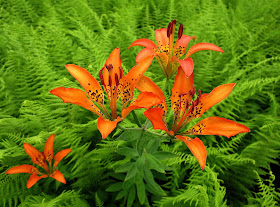There is ALWAYS something of interest to engage my lively and perceptive friends who belong to our Thursday group. We had hardly emerged from where we parked our cars along Spier Falls Road, when Ed Miller pointed out the gorgeous stand of Shining Sumac (Rhus copallinum) that lined the road. This species of sumac is noted for its glossy leaves, as well as the winged stems of its compound leaves.
And these friends never dismiss our common roadside "weeds" as just weeds of no account, but take the time to distinguish their species -- as well as marvel at the beauty that some introduced plants like these Maiden Pinks (Dianthus deltoides) add to the otherwise neglected roadsides. One of our group was careful to point out the dark ring that surrounds the center of each of these flowers, a mark that distinguishes these pinks from the similar Deptford Pinks that also appear now along roadsides.
As soon as we entered the wooded area that led to the powerline clearing, we were greeted by a pretty patch of Shinleaf Pyrola (Pyrola elliptica) just opening its white blooms.
Out under the sky that now sprinkled a few drops of rain, we began to see the plants that are adapted to such sandy, sun-baked terrain as powerline clearcuts. New Jersey Tea (Ceanothus americanus) is one of these plants, and its flowers that look like clusters of exploding stars were well in bloom.
The Butterfly Weed (Asclepias tuberosa) was just beginning to open its vivid orange buds.
Ah, but the even more vividly orange Wood Lilies (Lilium philadelphicum) were beautifully open, holding their gorgeous blooms toward the sky for all to see!
Amazing! What a great gift from Mother Nature's garden!
Not nearly as colorful, but infinitely more fragrant, several stalks of Clasping Milkweed (Asclepias amplexicaulis) stood by the path, attracting lots of bees and bugs and butterflies to its perfumed blooms. Note the stem-clasping leaves with their wavy edges, and also the erect, rather than drooping flower cluster, two factors that distinguish this milkweed from others of its genus.
When we came to where our powerline ended atSpier Falls Road, I urged my friends to cross the road and walk a ways on another stretch along the line. We will see Greenish-flowered Pyrolas (Pyrola chlorantha) down there, I promised. And so we did. The ones we found were well past their prime, but I had taken this photo last week, and we did find a few that looked almost like this.
And here were more Wood Lilies, poking their stunning blooms skyward from an otherwise monocultural stand of lime-green Hay-scented Ferns (Dennstaedtia punctilobula).
One of those lilies was making the most of its crowded space by producing three blooms on one stem!
On our way back the way we had come, I guided my friends over to where the woods edged the powerline, a shady stretch where patches of Intermediate Wood Fern (Dryopteris intermedia) thrived beneath oaks and pines.
We turned the fern's fronds over to see the ripening spore clusters (sori) on the backs of the pinnae.
After walking the sandy, hard-beaten track under the powerline, it felt marvelous to feel our feet sink into thick carpets of soft moss as we walked along the edge of the woods.
Here where the White Pines grew thick in the woods, we found the leaves of more Pink Lady's Slippers (Cypripedium acaule) than we could count, scattered among mats of Haircap Moss (Polytrichum commune).
There were fallen logs here, and stumps that were covered with liverworts, mosses, lichens, fungi, and slime molds. This particular stump was home to the liverwort called Lovely Fuzzwort (Ptilidium pulcherrimum) and was being visited by some bright yellow Scrambled Egg Slime Mold (Fuligo septica).
We found more of that Scrambled-egg Slime Mold on some pine needles scattered across the Haircap Moss.
And here was a lovely clump of moss colored chartreuse and pink, set among some tufts of Tree Club Moss. I failed to get the name of this moss, although I think I heard one of our group refer to it as a false sphagnum.
Here's a flower that was quite a surprise, even for me. I've visited this powerline at least three times in the last week, and never once did I spy this wee little flower, called Dwarf Dandelion (Krigia virginica), until this Thursday. Maybe it wasn't yet in bloom. Or maybe it's really easy to overlook, it being so very small. Those little yellow flowers were only a quarter inch across, and they grew very low to the ground.
There were other plants, too numerous to mention, but I can't leave this post without mentioning the abundant shrubs of American Hazelnut (Corylus americana) that thrive in this sandy open area. The shrubs were thick now with the ruffly green nut clusters that resemble green carnations. And one of those ruffly nut clusters was providing a shelter for this little baby Marbled Orb Weaver, one of our prettiest spiders, with its yellow-and-black striped legs and intricately patterned abdomen.
Oh, and I can't forget to mention the other babies, hundreds of them, the itty-bitty, wee little American Toads, just out of the tadpoles and hopping all over the place. We thought they might be crickets until we took a closer look. Adorable!
Well, we had had quite a walk, on our feet for nearly three hours, and we were getting hungry and tired. And look what we found as our reward, just as we were leaving the powerline to reach our cars: some Lowbush Blueberry bushes, loaded with ripe fruit! We spent a few more minutes here, plucking and eating ripe berries, and feeling lucky to be alive in such a beautiful world.















































































